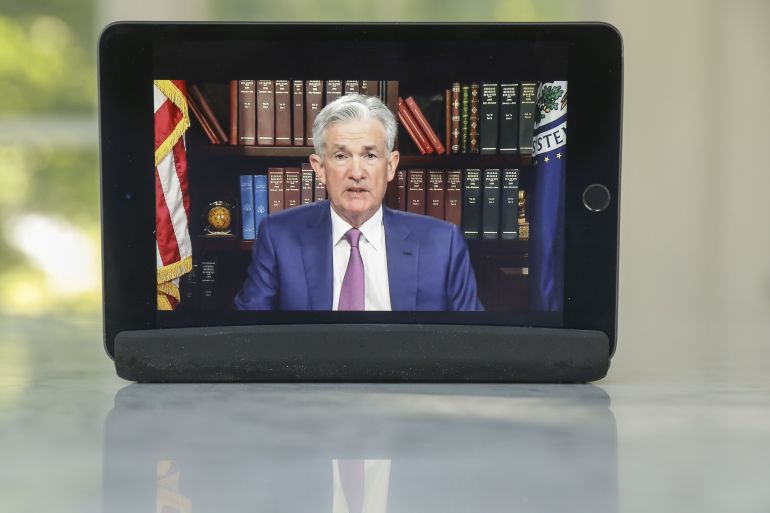US Fed chief talks tapering in 2021 at Jackson Hole symposium
US Federal Reserve Chairman Jerome Powell reiterated that a decision to taper off the Fed’s $120bn in monthly asset purchases doesn’t mean it will be raising interest rates at the same time.

United States Federal Reserve Chairman Jerome Powell kicked off this year’s annual Jackson Hole Economic Policy Symposium on a positive note, telling policymakers he believes “substantial further progress” has been made on some metrics and signalling he believes the time is right for the Fed to start tapering off some of its economic support.
“My view is that the substantial further progress test has been met for inflation,” Powell said Friday. “There has also been clear progress toward maximum employment.”
Keep reading
list of 4 itemsInflation watch: Key US price gauge rises as spending moderates
OPEC+ expected to stick to output hike as oil prices bounce back
US retail sales dip amid inflation, shift to spending on services
Powell’s remarks were delivered virtually after a surge in COVID-19 cases in Wyoming forced organisers to scrap in-person plans for the annual symposium, which draws central bank leaders, academics, government officials and other market participants from around the world.
Powell’s remarks were closely watched by investors and analysts wondering about the Fed’s planned pace for tapering off its asset purchases.
To support the US’s economic recovery from the coronavirus pandemic, the Fed has been making $120bn in monthly asset purchases, including at least $80bn in Treasury securities per month and at least $40bn in agency mortgage‑backed securities per month.
But amid signs that the recovery is beginning to take hold, the timeline to wind down those purchases has been the subject of debate among Fed officials – and speculation among analysts and investors.
At the Federal Open Market Committee’s July meeting, minutes show that leaders discussed tapering off asset purchases before the end of 2021.
In his speech Friday, Powell said he was among the majority participants in that meeting who were of the view “that if the economy evolved broadly as anticipated, it could be appropriate to start reducing the pace of asset purchases this year”.
“The intervening month has brought more progress in the form of a strong employment report for July, but also the further spread of the Delta variant,” Powell said.
US employers added 943,000 jobs to their payrolls in July, US Department of Labor data showed, beating many economists’ forecasts. The number of unemployed workers in the US fell by 782,000 last month to 8.7 million.
Initial jobless claims rose slightly by 4,000 for the week ending August 21 after hitting a pandemic low of 348,000 the previous week, according to Labor Department data.
But the US isn’t out of the woods yet when it comes to the pandemic. COVID-19 cases caused by the highly contagious Delta variant are surging in some states, especially among unvaccinated people.
The seven-day moving average of daily new cases stood at 133,056 as of August 20, a 14 percent increase from the previous seven-day moving average, according to data from the US Centers for Disease Control and Prevention.
Meanwhile, just over 50 percent of Americans are fully vaccinated against the coronavirus, and the pace of vaccinations has not kept up with the spread of infections.
Powell acknowledged the challenges still presented by the pandemic in his speech Friday.
“We will be carefully assessing incoming data and the evolving risks,” he said. “Even after our asset purchases and our elevated holdings of longer-term securities, we will continue to support accommodative financial conditions.”
He also reiterated that tapering off asset purchases doesn’t mean the Fed will be raising interest rates from their near-zero levels at the same time.
“The timing and pace of the coming reduction in asset purchases will not be intended to carry a direct signal regarding the timing of interest rate liftoff, for which we have articulated a different and substantially more stringent test,” Powell said.
“We have said that we will continue to hold the target range for the federal funds rate at its current level until the economy reaches conditions consistent with maximum employment and inflation has reached two percent and is on track to moderately exceed two percent for some time,” he explained.
The US is experiencing inflation above that target currently, but whether it is largely transitory – as Powell has said – or something more worrisome is the subject of debate.
On Friday, Powell reiterated his view that inflation is temporary and “is so far largely the product of a relatively narrow group of goods and services that have been directly affected by the pandemic and the reopening of the economy”.
As more data becomes available, a clearer picture should also emerge about the scope of inflation.
“The 12-month window we use in computing inflation now captures the rebound in prices, but not the initial decline, temporarily elevating reported inflation,” Powell said. “These effects, which are adding a few tenths to measured inflation, should wash out over time.”
Powell closed by reiterating that while “we have much ground to cover to reach maximum employment”, he believes the US economy can get there.
“Before the pandemic, we all saw the extraordinary benefits that a strong labour market can deliver to our society,” he said. “Despite today’s challenges, the economy is on a path to just such a labour market, with high levels of employment and participation, broadly shared wage gains and inflation running close to our price stability goal.”
The Fed Open Market Committee is next set to meet from September 21 to 22.